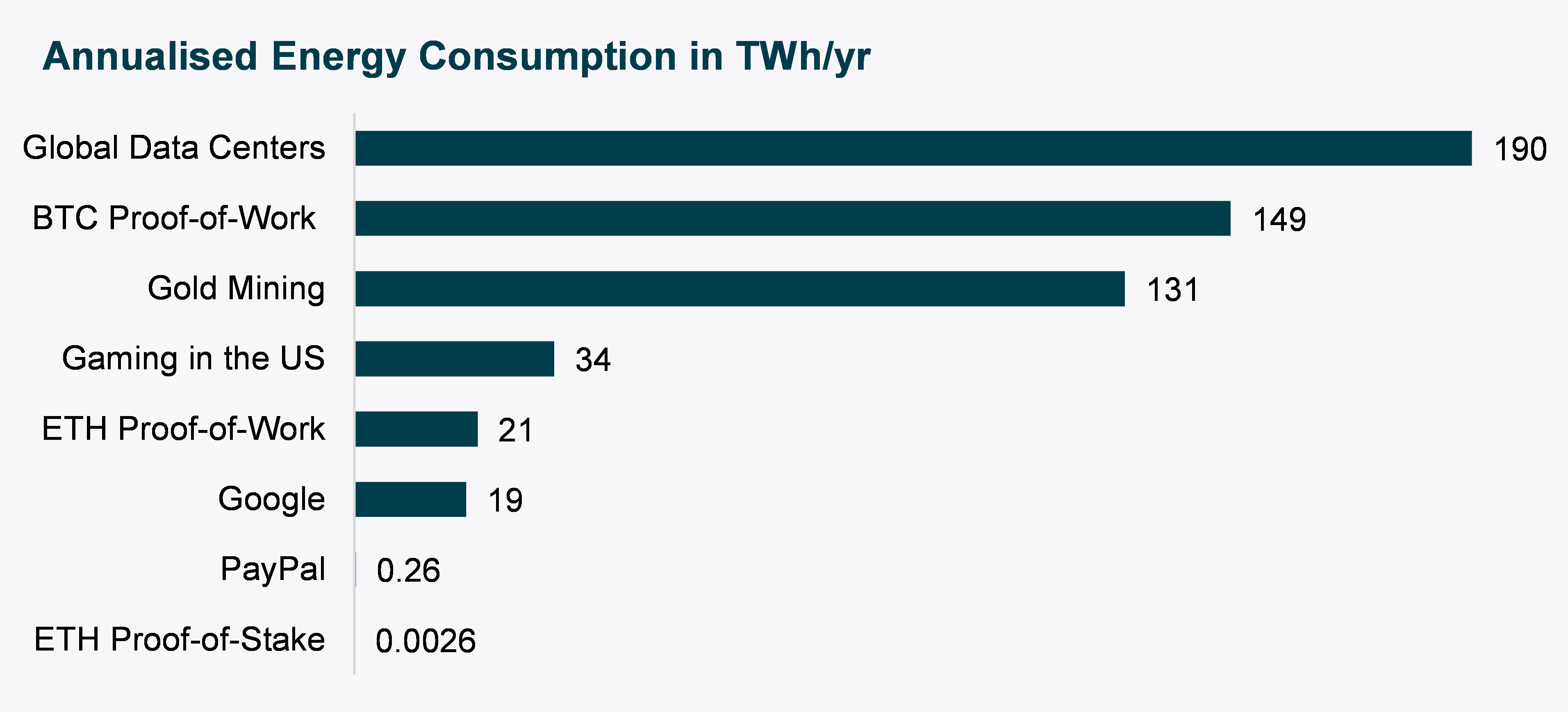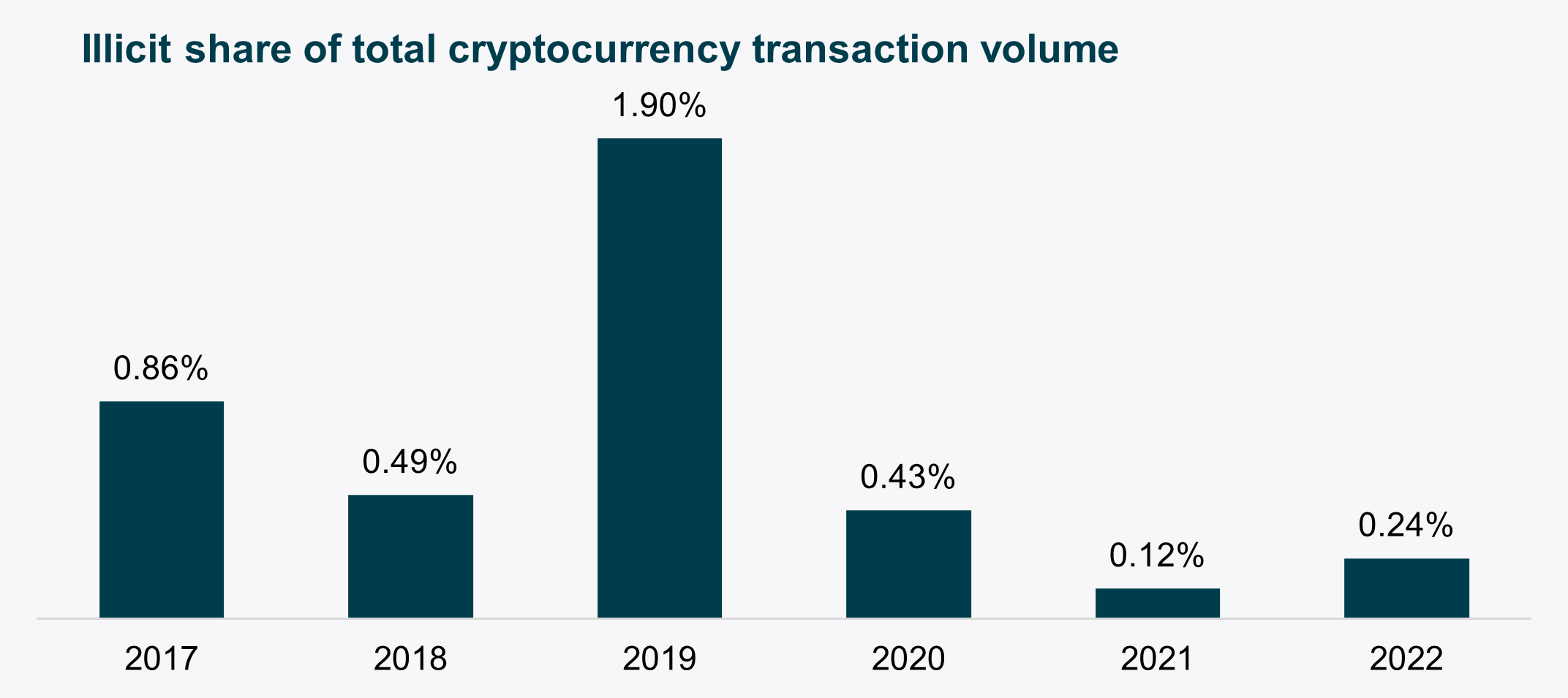In a rapidly evolving financial landscape, where climate change is a hot topic and social factors garner increased attention, the role of cryptocurrencies is becoming more discussed. With environmentally friendly consensus and a growing emphasis on inclusive financial systems, the crypto market is undergoing a transformative phase.
In this article, we analyse the intersection of environmental, social, and governance (ESG) considerations within the crypto space. From the sustainability of mining practices to the democratization of finance, the key takeaways shaping the future of cryptocurrencies as responsible investment assets are revealed.
Bitcoin's environmental impact
According to the New York Times, Bitcoin mining consumes approximately 0.5% of the world’s total energy production. Estimates attribute 60-77% of global crypto-asset electricity usage to Bitcoin alone. The US leads the global Bitcoin mining industry, producing more than 38% of the network’s hash rate. In May 2023, Bitcoin mining devoured about 95.58 terawatt-hours, peaking at 204.5 terawatt-hours in 2022, surpassing Finland’s annual power consumption. In fact, a single Bitcoin transaction consumes energy equal to nearly 100 thousand Visa transactions.
The energy-intensive nature for the Bitcoin network stems from its Proof-of-Work (PoW) mechanism. It is essential for security and to maintain its decentralisation. This mechanism is designed in a way that miners compete to create the next block and get rewarded in Bitcoin. As only the fastest miner earn rewards, mining has become an industry where thousands of mining racks compete against each other and run in parallel to solve cryptographic puzzles. It is important to note that miners are the sole parties securing the network. They ensure that no transactions are fraudulent. The Bitcoin reward incentives help retain miners within the network, thereby preserving security. The consumed energy is thus not wasted, but is used in securing the network.
Decarbonizing the crypto industry
However, in response to environmental concerns, the Crypto Climate Accord (CCA) aims to decarbonize the crypto industry by transitioning to renewable energy by 2030 and achieving net-zero greenhouse gas emissions by 2040. At present, the accord is focused on two primary goals:
- Attaining net-zero emissions from electricity usage among CCA Signatories by 2030.
- Collaborating with CCA Supporters to establish benchmarks, resources, and technological advancements that expedite the integration of fully renewable-powered blockchains. The aim is to confirm advancements toward this objective by the 2025 United Nations Framework Convention on Climate Change Conference of the parties 30, in short UNFCCC COP 30 conference.
Energy sourcing for mining has also evolved over time. The Bitcoin Mining Council, comprising 48.4% of global miners, reported that 58.9% of Q4 2022’s mining electricity originated from renewables, a figure that declined to 52% in 2023. These renewables currently encompass hydro, wind, solar, and nuclear power. Some models also predict a 6.2% yearly increase in Bitcoin’s sustainable network composition.
Bitcoin extensive energy consumption is a consequence of the PoW consensus mechanism. We observe the mix of energy used to produce Bitcoins is becoming more sustainable but the use of energy remains elevated. Looking at Ethereum, or more generally Proof-of-stake (PoS) blockchains, leads to a different conclusion as the mechanism guaranteeing the security of the chain does not depend on energy anymore.
Ethereum's environmental impact
Contextualizing Ethereum’s energy consumption involves comparing its annualized estimates with various industries. Operating on a PoS consensus mechanism, Ethereum utilizes its native cryptocurrency ETH instead of traditional energy sources to secure its network. According to a Crypto Carbon Ratings Institute (CCRI) study, the network’s global energy consumption is approximately 0.0026 TWh/yr (terawatt-hours per year). To provide a clearer perspective, the pre-Merge proof-of-work Ethereum consumed 8100 times this amount. Bitcoin’s consumption remains at 53,000 times this level. The payment network PayPal consumes about 100 times this energy amount, estimated at 0.26 TWh/yr.

Figure 1: Visualisation of the power consumption of ETH Proof-of-Stake / Source: Ethereum Foundation, AMINA Bank
Post the implementation of The Merge, Ethereum electricity consumption reduced significantly, plummeting by over 99.95%. This significant decrease coincided with a staggering 99.992% drop in its carbon footprint. This notably enhances both environmental sustainability and network security. Beyond its remarkably low energy usage, Ethereum nurtures a vibrant regenerative finance (ReFi) community too. Leveraging Ethereum’s infrastructure, ReFi applications develop financial tools that actively contribute to positive environmental impacts. These initiatives span support for blockchain-based digital carbon markets, technological advancements in carbon credit validation and transactions, facilitated by blockchains’ transparency and enhanced accessibility.
Among platforms like Gitcoin, designed to fund public goods within the Web3 ecosystem, climate rounds promote environmentally conscious development on Ethereum’s application layer. These initiatives, coupled with endeavors like decentralised science (DeSci) that enable scientists raise funding and build on the open science movement, position Ethereum as a technology fostering positive environmental and social outcomes.
Is Proof-of-Stake the way forward?
Unlike PoW, the mechanism driving PoS is energy conserving. Contrary to PoW, where miners compete to mine the next block, PoS validators are randomly chosen to validate the next block on the blockchain network. As a result, PoS validators do not need more computers or expensive hardware to get higher rewards. They need to lock more coins (of the native cryptocurrency) in the network to increase their chance of being selected in the next validating round. In addition to energy efficiency, PoS allows anyone to contribute to network security via delegation of their native coins to a particular validator and earn rewards.
PoS also creates more opportunities for scaling the capacity of the blockchains. With sharding, for example, smart contracts can run in parallel, increasing throughout and reducing (gas) fees on the network. The prevalence of PoS across most new networks indicates its potential as the future of blockchain and cryptocurrencies. This trajectory is not only rooted in technical advantages but also underscores its capacity to significantly reduce energy consumption.
Financial inclusion
Improving financial inclusion is vital for ensuring everyone has access to basic financial services and opportunities. Engaging in crypto transactions merely necessitates two essential elements: an internet connection and a communication device, preferably a simple smartphone. Encouragingly, the adoption of smartphones is progressing rapidly. Currently, 6.72 billion individuals (roughly 82% of the global population) utilize smartphones. When considering this alongside sustained internet availability, the accessibility of cryptocurrency transactions is poised to increase progressively in the future.
With many people worldwide still being left out of the traditional financial system, cryptocurrencies offer a way to bridge this gap and help more people join in. The absence of intermediaries in crypto makes them a great fit for bringing financial services to communities that do not have access to traditional banks. Unlike traditional bank accounts, there is no minimum amount to open a crypto wallet, no maintenance fees, only transaction costs. This opens opportunities for those who could not use standard financial services to make transactions, save money, and get credit.
Social inclusion
The United Nations estimates that roughly 800 million people in the world are recipients of flows of money sent by their family members who have migrated for work. According to the World Bank, remittances are on average 6.20% of the amount sent. Sending money through regular banks can be slow and costly. However, with cryptocurrencies, one can send money almost instantly and at much lower costs. While traditional banking systems take days for transfers, cryptocurrencies like Bitcoin and Ethereum can do it in minutes, or even seconds on platforms like Solana, Avalanche and Arbitrum.
The latest Chainalysis report places the Central & Southern Asia and Oceania (CSAO) region at the forefront of the global crypto adoption index. CSAO hosts six of the top ten countries in this ranking. While grassroots crypto adoption has witnessed a decline globally this year, there has been a noticeable rebound from the lull experienced in late 2022, coinciding with the period of FTX’s downturn.

Table 1: Global Cryptocurrency Adoption Rankings / Source: AMINA Bank
Illicit activities
According to the United Nations, illicit activity represents between 2 and 4 % of global GDP. This puts global corruption at USD 2 trillion (going by World Bank’s estimates). Chainalysis reported an increase in illicit transaction volume despite the market’s downturn last year. Reaching a record high of USD 20.6 billion, marking the second consecutive annual increase. The year 2022 was tumultuous in cryptocurrency history. 2022 witnessed the collapse of several major firms, including Celsius, Three Arrows Capital, FTX, and others, with some facing allegations of fraudulent activities.

Figure 2: Illicit share of total cryptocurrency transaction volume / Source: Chainalysis, AMINA Bank
Notably, 43% of the illicit transaction volume in 2022 was linked to activities associated with sanctioned entities. This surge occurred in a year when the Office of Foreign Assets Control (OFAC) initiated some of its most ambitious and challenging crypto sanctions. While the share of cryptocurrency activity tied to illicit behavior increased for the first time since 2019, rising from 0.12% in 2021 to 0.24% in 2022, it is crucial to note that overall illicit activity in cryptocurrency represents less than 1% of the total volume.
Governance of Ethereum
Blockchain protocols are networks, granting authority to those who can alter the code. The thereby hold the ability to shape or disrupt the network. Governance for cryptocurrency therefore plays a pivotal role in ensuring network security, overseeing protocol evolution and nurturing community consensus. Fostering transparent decision-making to maintain stability is crucial for any network’s decentralisation. In managing protocols, governance functions either off-chain or on-chain. Established blockchains like Bitcoin and Ethereum employ off-chain governance, allowing participation in protocol changes without possessing the native currency of the protocol.
On Ethereum, this is done through Ethereum’s EIPs (Ethereum Improvement Proposals) which are publicly listed and reviewed by involved participants. A member typically introduces an EIP on the governance forum, presenting a comprehensive outline of the proposed technological alterations and the rationale behind the suggestion. The community offers feedback, which is relayed to the core developers during the “AllCoreDevs call.” Subsequently, a decision is made whether to proceed, postpone, or dismiss the proposal. If it progresses, the EIP undergoes iterations based on feedback from pertinent members, culminating in a final proposal. This final version is tested on test nets before being slated for implementation on the Ethereum Mainnet.
Governance of other blockchain ecosystems
The Bitcoin Network employs a similar process through Bitcoin Improvement Proposals (BIPs). Informal proposals garner community feedback, progress to become BIPs based on substantial support. BIPs undergo transparent review and testing within the developer community before immediate code-based blockchain alterations. A significant miner consensus is then required to incorporate the change. Similarly, dapps (decentralized applications) follow a governance process distinct from core developers. Dapps often incorporate governance tokens for on-chain voting via platforms. This was implemented for example by snapshot.org, who determine implementation based on weighted average token-holder votes. However, governance transparency can be imperfect. Concerns are made regarding decentralized participation authenticity. Especially when anonymous market participant identities obscure actual token ownership and influence.
The distribution of coins at inception (referred to as the project’s tokenomics) crucially influences governance analysis, clarifying token holders’ incentives for decisions. Increased transparency and wider participation in decision-making often result in slower governance processes, requiring detailed procedures, even in emergencies such as bugs or critical issues. In case of emergencies (for instance, a bug), an elaborate proposal and voting procedure must be done appropriately.
The realm of ESG governance acknowledges imperfection and crypto governance is still in its formative stages. The evaluation of cryptocurrency governance is a nuanced, case-by-case process. For instance, Bitcoin’s governance embedded within its protocol mitigates misuse by virtue of its decentralization. Similarly, sufficiently decentralized cryptocurrency ecosystems, like Ethereum, boast robust governance through democratic processes. As the crypto industry advances, there will likely be a heightened focus on defining and quantifying ESG criteria that suit the distinctive attributes and complexities of blockchain and cryptocurrencies. This evolution will center on refining the understanding and measurement of ESG factors within the unique landscape of these technologies.
ESG in crypto: conclusion
This article delves into ESG considerations within the cryptoc and digital assets industry. It explores climate impact, financial inclusion, social aspects, illicit activities, and governance. ESG standards cover a broader spectrum, however it was focussed on specific factors. These arose from recurring discussions with clients and the need to address prevalent market misconceptions. While definitively aligning cryptocurrencies with ESG remains complex, many exhibit alignment, particularly the shift toward more ESG-friendly protocols. This is witnessed in the transition from power-intensive proof-of-work protocols like Bitcoin towards energy-efficient proof-of-stake alternatives. These are the likes of Ethereum, Solana and Avalanche. Integrating ESG principles into crypto emphasizes environmental awareness, social responsibility and ethical governance. Drawing investor compatibility, and sustainable practices, aligning the industry with prevailing global values and trends.








